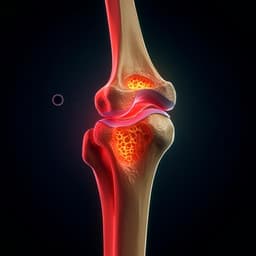
Physics
Wideband coherent microwave conversion via magnon nonlinearity in a hybrid quantum system
J. Wu, J. Liu, et al.
Discover an innovative microwave frequency conversion method that integrates nitrogen-vacancy centers in diamond with a magnetic thin film. This research, conducted by Jiahao Wu and colleagues, showcases a remarkable bandwidth and high-order frequency conversion, paving the way for advanced frequency detection and qubit control in the exciting realm of spintronics.
~3 min • Beginner • English
Introduction
The study addresses the challenge of frequency matching between disparate solid-state qubit systems, which typically operate at different microwave resonance frequencies spanning several to hundreds of GHz. Traditional methods for coupling such systems and for microwave quantum sensing often require large, tunable magnetic fields, which can alter sample dynamics, complicate miniaturization, and add noise. The authors seek a passive, on-chip, wideband microwave frequency conversion method that can coherently bridge frequency gaps between solid-state qubits and enable broadband sensing without sweeping large magnetic fields. They propose leveraging nonlinear magnetic responses in spintronic devices—specifically domain-wall-induced symmetry breaking in magnetic thin films—to enable coherent microwave frequency conversion in the near field, suitable for integration with spin qubits such as NV centers in diamond.
Literature Review
Prior work in nonlinear optics established frequency conversion via electric nonlinearities, enabling broad applications including laser engineering and quantum system coupling. Considerable efforts target microwave–optical transduction to support long-distance quantum communication. Within solid-state quantum technologies, disparate qubit resonance frequencies hinder hybrid integration. NV-based quantum sensing typically employs T1 relaxometry with large bias fields to match signal frequencies, risking distortion of intrinsic sample dynamics. In magnetics, strong magnon–microwave interactions are known, and nonlinear phenomena including four-wave mixing in YIG (via FMR) and high-order harmonics up to the 50th order in NiFe films (beyond FMR, attributed to switching effects) have been reported. These insights suggest magnetic nonlinearities could provide higher-order and wider-band frequency conversion pathways than traditional electric nonlinearities, motivating the present approach focused on domain-wall-induced symmetry breaking as a strong nonlinear source.
Methodology
Device and hybrid system: A 100 nm Au/15 nm CoFeB/2 nm TaOx coplanar waveguide (CPW) with 50 µm center conductor and 20 µm gaps was fabricated on SiO2/Si by magnetron sputtering; TaOx caps CoFeB against oxidation. The CPW was wire-bonded for microwave delivery. Two NV configurations were used: (1) nanodiamonds dispersed on the CPW, and (2) a bulk diamond with near-surface implanted NV centers positioned close to the CPW. The NV–CoFeB standoff could be up to ~5 µm due to particulate contamination. The static magnetic bias field was applied parallel to the film and waveguide (in-plane), perpendicular to the microwave magnetic field.
Sensing and readout: NV centers were initialized and read out under 520 nm green laser excitation using confocal microscopy and an avalanche photodiode. ODMR was used to detect resonant microwave fields (both GS-ESR near 2.87 GHz at zero field and ES-ESR), with Zeeman shifts under applied bias. Microwaves were carefully filtered to exclude spurious nonlinearities from microwave components.
Nonlinear response measurements: The team swept a single pump microwave fpump and varied the bias field Bbias to map ODMR responses due to harmonic generation, identifying conditions where n·fpump ≈ fESR (integer n) induced PL reductions indicative of harmonic conversion. Comparative measurements were performed on CPWs with/without CoFeB and at positions above the CPW/gaps to attribute nonlinear signals specifically to the ferromagnetic film.
Multi-wave mixing experiments: Two microwave sources at f1 and f2 were applied simultaneously to the CPW. The authors swept frequencies and observed ODMR contrast when a·f1 + b·f2 = fESR (a,b integers), evidencing three-wave, four-wave, and higher-order mixing products. Spectra were compared with theoretical predictions from polynomial nonlinear magnetization models M(t) = χH + χ(2)H2 + χ(3)H3 + …, where χ(2) enables sum/difference-frequency generation, and higher orders support complex mixing.
Micromagnetic simulations: Using Mumax3, the authors simulated static domain configurations (single wall, double wall, low- and high-density multi-domain) and driven dynamics. An rf field of 800 µT at 287 MHz (y-direction) and a 1.0 mT static field (x-direction) replicated experimental geometry. FFT analysis extracted magnetization components at 2870 MHz (10th harmonic) to evaluate spatial distributions and spatially averaged responses. Parametric variations probed the impact of domain-wall length/density and width on nonlinear response.
Magnetic texture characterization: In-plane MOKE microscopy provided hysteresis loops and domain images versus bias field, identifying bias ranges with abundant zigzag domain walls (−0.5 to −2.5 mT) correlated with enhanced nonlinear harmonic generation. Saturation at ~9 mT reduced nonlinear responses, indicating additional (weaker) nonlinear sources at edges/interfaces.
Coherent control tests: Rabi oscillations were driven at fESR/N (N = 2,3) using harmonically converted microwaves to assess coherence and conversion efficiency. Rabi frequencies versus drive amplitude established scaling behaviors and allowed extraction of relative harmonic power fractions under a fixed pump power (20 dBm). Additional tests showed frequency-mixed signals could also drive coherent control.
Sensing protocols: Demonstrations of up-conversion (f1 + f2 = fESR) and higher-order down-conversion (e.g., 2f1 + fESR = f2) enabled detection of target signals (e.g., f2 = 0.4 GHz, 10 GHz) under fixed bias fields without high-frequency pumps or large tunable fields, indicating broad applicability to T1 relaxometry and beyond.
Key Findings
- Achieved wideband coherent microwave frequency conversion from 0.1 to 12 GHz (instrumentation-limited; potentially tens of GHz).
- Observed high-order harmonic generation in CoFeB thin films detectable by NV ODMR, with at least 25th harmonic order; peaks occur at integer fractions of fESR (e.g., 7th harmonic at ~410 MHz pump driving ~2.87 GHz ESR response).
- Demonstrated rich multi-wave mixing: signals satisfy a·f1 + b·f2 = fESR, including rare high-order processes such as 6th-order mixing (3f1 − 3f2 = fESR).
- Nonlinearity mechanism: strong magnetic nonlinearities originate primarily from symmetry breaking in domain walls; enhanced harmonic intensity correlates with increased domain-wall length/density and narrower walls (micromagnetic simulations). Maximal nonlinear response appears for bias fields −0.5 to −2.5 mT (abundant domain walls). Nonlinear signals persist, though weaker, even in saturated magnetization (9 mT), indicating additional sources (edges/interfaces).
- Coherent control via converted signals: Rabi oscillations driven at fESR/3 exhibit linear scaling of Rabi frequency with drive amplitude within measured range, suggesting near-constant third-order conversion efficiency under those conditions. Under a 20 dBm pump, extracted relative energy ratios: second harmonic ~9.1%, third harmonic ~5.9% (conversion efficiency decreases with order).
- Sensing demonstrations: Up-conversion enables detection of a 0.4 GHz target via f1 + f2 = fESR. Down-conversion schemes (first- and second-order) allow detection of a 10 GHz target without high-field tuning and with more accessible pump frequencies, providing spectral fingerprints for targets.
- Near-field implementation avoids phase-matching constraints and is compatible with on-chip integration with spin qubits.
Discussion
The results show that magnetic-domain-wall-induced nonlinearities in spintronic films provide a powerful, compact platform for near-field microwave frequency conversion and multi-wave mixing. By converting arbitrary microwaves into resonant frequencies of spin qubits (e.g., NV centers), the method addresses frequency mismatches that limit hybrid quantum networking and enables broadband sensing without large tunable fields. The preserved coherence of converted microwaves, confirmed via Rabi oscillations and mixing-driven control, demonstrates suitability for coherent coupling and manipulation across systems. The dependence of nonlinear strength on domain-wall density/width and observed responses even in saturated states suggest multiple engineerable nonlinear sources (domain walls, interfaces, edges). This tunability offers a pathway to optimize conversion efficiency and bandwidth. Moreover, leveraging established NV sensing protocols (heterodyne detection, Ramsey, dynamical decoupling) after conversion can further enhance sensitivity by converting high-frequency targets into favorable detection bands. Overall, the work extends nonlinear frequency conversion from electric to magnetic domains, opening new capabilities for on-chip quantum interfaces and sensing.
Conclusion
The study introduces and demonstrates a hybrid quantum spintronic approach for wideband coherent microwave frequency conversion by exploiting strong magnetic nonlinearities in CoFeB thin films integrated with NV centers in diamond. It achieves conversion across 0.1–12 GHz with up to 25th-order harmonics, rich multi-wave mixing, and maintains coherence sufficient for Rabi control. Applications include broadband quantum sensing under fixed magnetic bias and potential coherent coupling of disparate solid-state qubits. Future directions include engineering magnetic textures (domain-wall length/width), tailoring material parameters (exchange stiffness, anisotropy), device-edge patterning (e.g., serrated edges), and using thinner or vdW magnetic materials to enhance nonlinearities. The approach paves the way for on-chip magnonic nonlinear components (e.g., IQ mixers, frequency multipliers) and integration with bio-sensing and cryogenic platforms.
Limitations
- The demonstrated bandwidth (0.1–12 GHz) is limited by available instrumentation; the true upper limit may extend to tens of GHz but is unverified experimentally.
- Specific contributions of interfaces and edges to nonlinearity are inferred but not conclusively isolated; further experiments are needed.
- Conversion efficiency decreases with harmonic order; observed near-linear scaling of Rabi frequency for third-order conversion suggests possible saturation or dissipation into thermal magnons, with mechanisms and upper bounds not fully resolved.
- Nonlinear response is strongest in a limited bias range with abundant domain walls and diminishes in saturation; performance depends on magnetic texture control.
- NV–film standoff distances up to ~5 µm (due to particulates) may reduce coupling; device-to-device variability (domain structure, roughness) can affect reproducibility.
Related Publications
Explore these studies to deepen your understanding of the subject.







